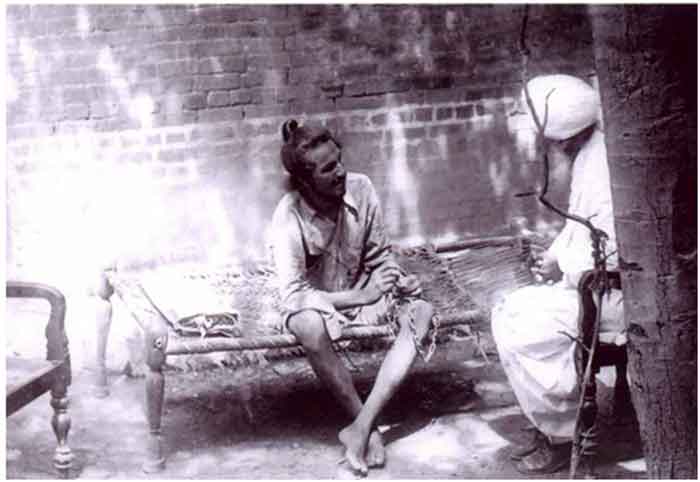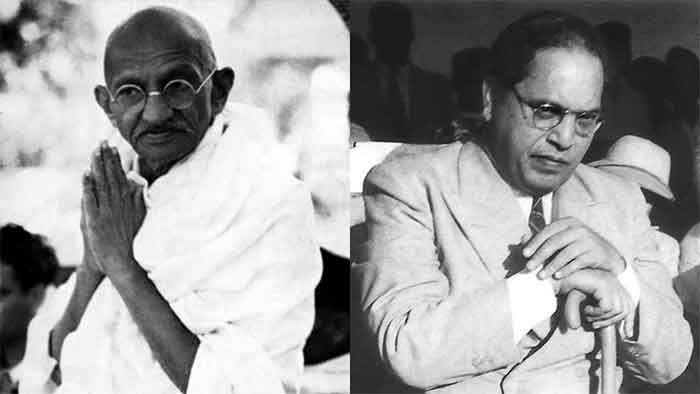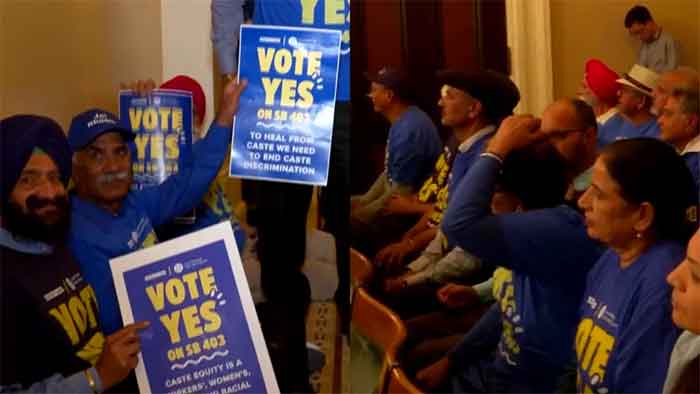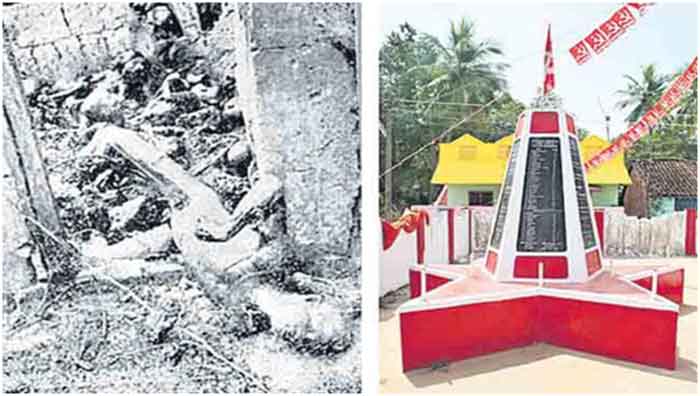
Pictures of Keelavenmani massacre, on Christmas night, 1968, and its memorial. 42 agri labor, most of them dalits- women and children- were burnt to death in the hut they had a meeting, the previous night, on wage rates. It was pre-meditated murder, in the presence of and aided by police, by landlords. One significant thing is often forgotten or omitted: It happened during the Periyarist rule of Annadurai, and all were acquited.
The courts after decades-long litigation, pursued by dravidian parties who had uninterrupted rule till now. This and such other incidents moved DV Rao, the veteran communist revolutionary of Telangana people’s armed struggle (1946-51) so much that he gave a call to resist all atrocities militantly, even while pursuing agrarian revolution, as the only way out: The Indian state after all is fully backing all reactionary forces, and the landlord system including its most heinous, feudal practices of caste oppression, he asserted.
Caste atrocities are still going on today, unabated and across India, in ever new forms and new names (cow-protection, beef consumption, lynchings and ‘honor killings’), even in Periyarist Tamilnadu, not to speak of the more backward states and regions. This, despite all reformers and reformist movements, and in spite of all reforms – Constitutional, legal, political – that failed to curb them.
This article, so relevant in these days of lynchings and honor killings, is being published on DV Rao’s 39th death anniversary. It remembers his above call and stand , ‘Resist Caste Atrocities Militantly,’ declared in his Defence Statement of Hyderabd Conspiracy Case Special Court, the first of its kind after 1947. The Special Court tried DV Rao, T. Nagi Reddy and 40 others in the famous Case, that charged them with sedition and allied things, (under IPC sections 120 to 124) the first of its kind after 1947.
He read it out in open Court over four days, Dec 14-18, 1971, in the aftermath of Keelavenmani and such other massacres.
The Defence Statement, one of his classic works, was published as a book with the title People’s Democratic Revolution in India – An Explanation of the Programme, 1971, (briefly PDR) that explains the General Line. This book of about 330 pages is one of his basic works. Among other things, he dealt with the caste question at some length in his classic work PDR. Extracts from that book are used in this article.
( The Proletarian Line Publications, 5-5-1022/107, Mallikarjuna Nagar (North), Chintalkuta, LB Nagar, Hyderabad-500 068.)
*** ***
DV Rao’s Life and work : A Brief Sketch
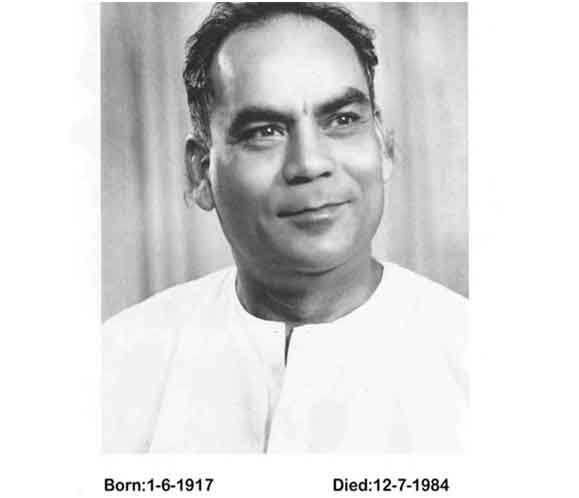
Prominent communist revolutionary (CR) leader of India, DV Rao (Devulapalli Venkateswara Rao 1917 June 1-1984 July 12), was known for his unique role in leading the historic Telangana People’s Armed Struggle (1940-51). Every year in July he, and his inseparable comrade-in-arms T. Nagi Reddy (TN 1917-1976), who also died in the same month, are remembered by thousands of people through various programs in Telangana and AP.
DV Rao was a rare theoretical, political, organizational, practical, cultural and military leader who left behind his extensive writings published in English and Telugu.
Born in 1917 in Nalgonda Dt of Hyderabad princely state, he began his political life as a communist revolutionary in 1939 and died as such on 1984 July 12.
Com DV spent around 17 years in underground activities and about 5 years in various jails (the ex-MP spent more than 10 years of UG life and all of jail life after the New Constitution of 1950) in his 45 years of political life and work as a communist revolutionary. Together with TN , he in 1975 founded the UCCRI-ML that ever since stood for a revolutionary mass line as different from right revisionist and left adventurist lines. He was its General Secretary from 1975 till he died at 67 in July 1984.
He stressed an Indian interpretation and Indian application of the universal world outlook of Marxism-Leninism-Mao’s Thought, reflected in his work and writings. That invariably included on caste system. Despite being a very active communist leader, representing the trend of revolutionary mass movement, he was a prolific writer from 1940s till 1984 July 12; his writings, theoretical as well as journalistic, were reflecting, and never divorced from, revolutionary practice.
More on his life and works is available in the valuable archives of countercurrents.org, which published several articles on and by him. One article that also focused on caste, is mentioned below:
Comrade DV Rao: Unique Role In Indian Communist Movement(2020)
https://countercurrents.org/2020/07/comrade-dv-rao-unique-role-in-indian-communist-movement/
*** ***
DV Rao on caste atrocities
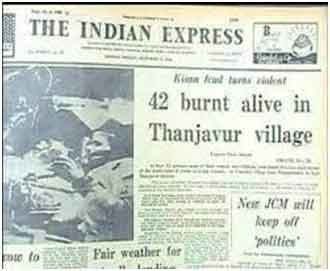
Keelavenmani massacre 1968, Madras state . Indian Express reported: ‘Kisan feud turns violent’. It was in fact landlords’ massacre of landless agri labor who were fighting for wage-hike. Forget as you do when people are killed by lightning, advised the then reformist, Periyarist CM Annadurai. But such atrocities continued till today, even in Tamilnadu. DV Rao cited that and such other incidents, and said only militant resistance will help.
DV Rao told the Court in 1971 about caste atrocities that were going on with impunity, despite claims of rule of law. The State connived with the oppressors, he asserted, and therefore armed militant resistance is the only way left for the oppressed people. His views are amply proved by events over the decades, and the situation in Modi-led India is worse than ever.
We give below excerpts, marked by deep empathy and anger, on the subject, taken from the concluding Chapter 13, sections 5 and 6, of PDR (p. 258-265. Emphases added.) :
One More Ghastly Incident in Bihar
We have already commented on the incidents of Keelavenmani of Madras and Behara near Varanasi in UP. We have more news of this nature. According to PTI news of November 25, 1971 the following is the ghastly incident that took place in the district of Purnea in Bihar:
“Patna Nov 23: The Chairman of the Socialist Party Mr.Karpoori Thakur alleged here today that 14 Santhal share-croppers, including two women, were killed in firing and arson by the men of big agriculturists in Rupaspur village, Purnea district on Monday.
“He told newsmen, that the incident occurred over a disputed land. He said, ‘when the landlords’ musclemen came, the Santhals hid inside their houses. The doors were bolted from outside, and the houses were set on fire. When the Santhals tried to flee, they were shot.’
“He said, six people, including two children were roasted alive, eight were shot and 61 others were injured, and later taken to hospital…
“He said similar incidents had occurred in 12 other places in the State, and in every case, the police and the Executive remained silent spectators.
“The Government is giving protection to the rich, and victimising the poor, he said.” (Times of India: 26-11-71)
In the village of Bhimavaram in Ongole district of Andhra Pradesh, a harijan had defeated a landlord in Panchayat elections, and became a Sarpanch in 1969. To avenge this, the landlord had murdered him in broad daylight. They attacked harijan houses, harassed and tortured the women, children and the old.
Today such incidents are taking place throughout the country. Only a few are coming to the surface through the press.
Armed landlords and their henchmen (with firearms) attacking the poor peasants and the labourers in an organised manner, is a common feature of all these incidents. Burning the houses while locking the people inside them, preventing them from taking water for drinking from public wells, preventing them from walking on the public roads are some of the atrocities that are common.
DV Rao continues his moving and picturesque narrative:
When the people are faced with such ghastly and organised incidents, the Constitution and the laws simply disappear.
After some days of such incidents, the police visit the place and encamp to protect the landlords from the wrath of the people, and not to protect the people.
The fact of the matter is, the people have nothing to protect. They have no properties, no big houses, no granaries, no gold and silver jewellery, no cash and no pro-notes. Their meagre possessions are a thatched house, cookery, and four or five lives in a house. By the time the police reach the village, the houses are burnt, the cookery is stolen, and some of the lives are lost. Thus, they have nothing left to be protected by the police. To say that the police had gone over there to protect the people is a mockery on the people.
After some more time, the incidents, to the extent they find a place in the newspapers, are mentioned in Parliament and the Legislatures. The representatives of the Government offer some explanation. And there ends the job of the parliamentary system.
We see the real culprits escape, and some second rate persons are involved in all such cases. There are cases when a few of them are awarded sentences of imprisonment for a brief period. More often than not, the police weakens the case against the landlords, and it is quashed. The issue goes into the background for the time-being.
The people never tolerate such atrocities. They prefer to offer resistance.
In all such cases, armed landlords and their henchmen are in the forefront in murders, burning houses, looting the properties of the people and the police coming to the help of the landlords is a familiar feature. During the last 25 years the government has provided licences for guns to the landlords on a large scale. They have heaps of unlicensed arms, besides what they have with licences. This development is not at all accidental. The landlords are armed to defend their class interests, to use them against the peasants and the workers, and finally to defend their power and exploitation.
The above incident consists of a conflict between landlords and tenants on the issue of tenancy, land rent, and crop-share, possession of land etc. These are tenancy problems which form part of the problems of agrarian revolution. The tenancy problem can be solved only when the tenants get ownership on their tenancy land and landlordism is abolished.
If the poor peasants are armed, they will put up armed defence to save their land, crop, hearth and home and their lives. Then, there would be no need for such things to happen in Bihar, Uttar Pradesh, Tamil Nadu and the other States.
They need not hide in their houses for fear of the armed landlords when they are on a chase.
They need not be helpless spectators when the rowdies are burning their houses, and they are being roasted alive.
They need not be shot down like sparrows when the landlords are chasing and firing at them.
It is quite possible that some lives of the people are lost during the armed resistance against the landlords. Instead of dying a helpless death in the hands of the landlords it is better to arm themselves, fight and die. It is all the more better to fight for land and sacrifice some of their lives.
Thus, it is clear that it is the class of landlords who have started a counter-revolutionary armed struggle against the peasantry.
The issue facing the Indian people and the peasantry is whether to put up an armed resistance or to live a life of slaves to the landlords.
The Indian peasantry has decided to resist with arms in the struggles, that have started earlier or are starting in the present days which are directed against the armed attacks of the ruling classes…
Thus the experiences of armed struggle in Telangana (1946-51), Naxalbari and Srikakulam conclusively prove that the first shot was fired by the armed forces of the government as well as the landlords, and the people resisted with arms, in self-defence, and in the defence of their small properties and their movements…
Had the people in Andhra not armed and defended themselves and their movement, every village would have become a Keelavenmani (Tamil Nadu) or a Behara (UP) or a Rupaspur (Bihar)…
It is those favourites who are making huge profits in arms trade and they have huge unlicensed arms dumps, while the purpose of the Arms Act is to disarm the people. The people are faced with armed landlords and their mercenaries, day in and day out.
Such being the situation, to say that the people can defend themselves in accordance with law, is to make fun of them.
If the disarmed people are to defend themselves, they have to adopt their own methods, which can be none other than revolutionary.
To form into an organised force, to learn to use arms and to secure arms are possible only in a revolutionary way. Then alone, can they defend themselves, and their organised movement. Then alone can they carry the revolution to a victorious end.
If there is no such thing, people have to choose to sacrifice themselves at the altar of counter-revolutionary armed attacks. The experiences of Keelavenmani (Tamil Nadu), Behara (Uttar Pradesh), and Rupaspur (Bihar) only prove this.
The people do not want to be at the mercy of armed counter-revolutionary ruling classes, who are at the same time the lackeys of imperialism and social imperialism.
The people want to overthrow them and seize power for themselves. Everyone knows that no Constitution and no law of the land permits the people to participate in a revolution, and to make it a success. They have to decide for it themselves and enforce them. The Indian people are no exception to this.
*** ***
‘Only agrarian revolution can help abolition of casteism’
That is one specific feature of Indian revolution: DV Rao
That is how DV Rao presents his revolutionary perspective. All reforms and reformist movements – constitutional, legal, educational, political, economic, social etc- failed to abolish casteism over the last 75 years. Liberalization and globalization too did not help, as even Indian NRIs carried and consolidated caste abroad. Former Chief Justice NV Ramana also said it during his latest visit to USA, on July 9. Hence only revolution can help: DV Rao asserted agrarian revolution and the struggle to abolish casteism are inseparable. That is one specific feature of Indian revolution.
His Statement in the Court is reminiscent of what Marx and Engels declared in the Communist Manifesto. Chapter IV concludes with these lines:
In short, the Communists everywhere support every revolutionary movement against the existing social and political order of things.
In all these movements, they bring to the front, as the leading question in each, the property question, no matter what its degree of development at the time…
The Communists disdain to conceal their views and aims. They openly declare that their ends can be attained only by the forcible overthrow of all existing social conditions. Let the ruling classes tremble at a Communistic revolution. The proletarians have nothing to lose but their chains. They have a world to win.
“Social” in Indian context includes casteism.
State, politics and caste
He asserted Reforms– religious, social, political, legislative- legal, cultural etc — over the decades and centuries, had failed to abolish not only casteism, but also its worst manifestation of untouchability.
As to impact of the Indian Constitution and laws, he minces no words and writes: “ The legislation banning untouchability has never seen the light of the day. It met the same fate as the efforts of Gandhiji to remove untouchability.” (p171, 2014 Reprint)
In this context, referring to a ground reality, the character of the Indian State, and contrasting reformist attempts with the need for a revolutionary alternative, DV Rao writes:
“The provisions in the Constitution, regarding the removal of untouchability and the economic improvement of the backward classes, are not being implemented, as far as the mass of the people are concerned.”
The government has dragged the people into the mire of casteism in order to divert the people away from class struggles. It is with this purpose that it is extending monetary help to caste institutions (hostels etc.). How then can they be class organisations?
DV Rao, while dealing with politics of caste and casteism, commented on Dalit Panther movement, which he welcomed, and wrote way back in March 1974 issue of Proletarian Path, a journal published for sometime from Calcutta and edited jointly by DV Rao and Moni Guha. He wrote:
“Experience has shown that social reformist movements and statutory safeguards can never emancipate the oppressed castes as long as the present political system continues because it defends the foreign interests and their native agents among whom landlords occupy an important position. One must adopt a revolutionary programme and policy and unite with all revolutionary forces which are working for emancipation of the oppressed people, to achieve abolition of casteism…
“They (Dalit Panthers) must unite with the revolutionary forces, which are working in our country.
“Agrarian revolution alone can emancipate the rural poor from landlordism. A revolutionary working class movement uniting all the oppressed in the urban areas, irrespective of castes or creed will have a leading role not only for the emancipation of the urban poor but for agrarian revolution also. Untouchables, being the most oppressed and forming the major part of the poor, have a key role to play among the poor.”
Proletarian dictatorship in relation to casteism
DV Rao was a rare communist who contemplated the need for proletarian dictatorship in relation to casteism.
He was well aware of the deep roots of casteism. Even while he narrated experiences of unifying oppressed masses and revolutionary classes, dalits, adivasis, as well other rural poor, through revolutionary movements and struggles, with agrarian revolution as the principal task, he saw the possible need for the use of revolutionary state power when, in the same book, he wrote:
On the other hand, a revolutionary power, which enforces the abolition of caste system with all the force at its command can alone do away with it….
( Though DV Rao did not give examples here, he elsewhere mentioned, as we can see Yadav Sena, Kurmi Sena, Vanniar hordes etc hunting rural poor, of SC as well as non-SC castes, and related bahujan poltics in this context. They are no answer to the problem.)
*** ***
Political prejudices against DV Rao
DV Rao’s unique contributions, including his views on caste system, were brought out in an assessment by Anand Teltumbde, renowned scholar and activist, who delivered Keynote Address in National Seminar (19th June 2017) on Revisiting the People’s History: Architect of the Telangana Armed Struggle – D.V. Rao. It was in the birth centenary year of Com DV Rao, who was a student of Osmania University.
So also by Inukonda Tirumali, who was born in a landless poor dalit family of Telangana, and became a Professor (Retired) of History in Delhi, who did his doctorate on Telangana (upto 1948 Police Action) and authored a significant book on it, Against Dora, who was the other key speaker of the day, and almost compered the program.
Tirumali was the unique scholar of JNU who could also go deep into official and police and intelligence records of the day, and found out the most critical and revolutionary role DV Rao had played in every phase of that struggle. His father was a participant of Telangana armed struggle and that gave added advantage as an expert on the subject.
(For more on this seminar and the assessment, see: countercurrents.org/2020/08/dv-rao-the-father-of-the-theory-and-practice-of-agrarian-revolution-in-india-anand-teltumbde/)
Several foreign scholars like Tariq Ali, Barry Pavier, Peter Custers came down all the way, had detailed, in-depth interviews with DV Rao, despite their differing ideological perspectives. Editors of EPW had some close interactions with him while he was UG, during Emergency 1975-76.
Half a dozen History Professors of JNU by Bipan Chandra had an 8-hours-long, rare and deep-going interview with DV Rao, a few days before DV Rao died (on July 12, 1984), with rich information and deep analysis.
These scholars knew that views and writings by the participant leader are a rich material for any student…That keenness was missing among many Indian scholars.
However, India’s official Left, or Left-overs as some one joked, was particularly guilty of ignoring DV Rao’s contribution. He is almost never found in the books and journals of official Left that mention scores of other leaders and cadres. It is somewhat like removal of Stalin’s name by post-Stalin CPSU, including from the famous Book, History of CPSU. Stalin’s name was pushed into some footnotes there, as is well known. CPM leader P. Sundarayya did exactly repeat this, omitting DV Rao except in footnotes, in his History of Telangana.
Many collections, and scores of volumes, of Indian communist documents and writings were published, by those associated with CPI, CPM, like by PPH, by NBA and others, but they omit DV Rao. Many associated with CPI-ML movements, post-Naxalbari, are no exception.
Very much like them, a section of India’s academics and arm-chair Marxists, prejudiced as they are, fail to see DV Rao’s immense contribution to Marxist theory in relation to Indian interpretation of communism, including on caste, through a significant and vast body of his writings. They are no exception to much of India’s slavish, West-oriented, and sponsored research. They quote, re-quote and re-circulate a few writers, including from the West, without any serious study of DV Rao.
Casteist prejudices against DV Rao
DV Rao once was asked by some foreign scholars about his caste. Is it a question I must answer, asked DV and answered: I was born in the most reactionary caste and class, the Brahmin caste and landlord class; and he ditched both.
Failing to see DV Rao’s revolutionary path and practice for Indian revolution, dealing with specified social and political tasks that are specific to India, a handful of capricious writers have been bent on spreading casteist prejudices against DV Rao.
They may not agree with him. Ignoring the realities of his whole life and work, some of these local writers who once respected him, but later on blinded by casteist theories and prejudices, wrote in-objectively, even abusively, calling him a ‘Brahmin communist’, with a ‘Brahminical outlook’.
One of them went too far, and commented : DV Rao wrote “as if there was no caste in India, ” refusing to see his practice, and works on caste.
Such was his contempt for facts that he stooped to say, falsely, “ DV Rao thought that all Indians should become vegetarian.” Incidentally, Rao himself was a meat eater. )
After age 40, people get into the problem of ‘long sight’, and can not see things very near to them. These two ‘teachers’- one was in a University, the other, a ‘teacher of social movements” – had DV Rao’s relevant writings in their own home, their friends tell us, but they were so ‘short-sighted’ that they could not – rather they did not like to- see what was written on caste, and casteism. They were lost in theories they cooked up without relevance to facts and realities.
One of them is such a scholar of social sciences and of caste, that he did not see a basic fact of Indian caste system. Writing an obituary on Usaa he wrote: “A barber had no right to enter the temple along with dalits.” In most South Indian temples, it is common knowledge, no ritual and festival is complete without the musical instruments – percussion-type as well as shehnai-type, played traditionally by those of barber community, sitting inside the temple, just facing the deity.
Many of the contentions made in that obituary were found to be wrong by Usaa’s close associates.
(See Kancha Ilaiah Shepherd, CC, 2020 Aug 4.)
The Telugu-speaking professor is so blind and ignorant of Andhra history, that he denigrated Andhra’s great reformers, Gurazada and Kandukuri as reformers of brahmin women only. It was Kandukuri and his wife -like Phule and Savitriba – who opened, a century ago in 1907 , in Rajahmundry, the first (Hita karini) school in Andhra that admitted dalit children, and girls in a co-ed school; and that at a time christian missionary school feared and refused to admit Mala (SC) students (see article of 2019 below).
https://countercurrents.org/2019/05/kandukuri-a-great-reformer-remembered-on-his-death-centenary/
The other ‘teacher’ Usaa began as a communist, turned into a OBC leader, and later was isolated as a leader of his caste organization. Both developed a common feature, blind hatred for DV Rao, who they alleged lacked concern for dalit-bahujans. They were Don Quixote and Sancho Panza who tilted windmills against DV Rao. Their names are irrelevant as they represented a degenerate part and trend of identity movements.
(See Kancha Ilaiah Shepherd, CC, 2020 Aug 4.)
Casteism is operating among communists too ?
DV Rao gave a rare media Interview, to Telugu Daily to Andhra Jyoti in May 1984, shortly before his death. Its English version was published in Proletarian Line No 47-October-November 1984.(p.No.9). In that DV explained how caste politics operated among communists too, more so after parliamentarism and vote-bank politics arrived. He said:
There was and is division among the people. We cannot wage armed struggle basing on any single caste or section of people… James Boswell, the biographer of the eminent English literary giant Samuel Johnson said, “Politics is the last resort of a scoundrel”. In our conditions we should say,“Casteism is the first resort of a political scoundrel”.
We can today see, more clearly than ever, how this wooing by the ruling classes, which DV Rao mentioned in 1974, increasingly enticed and entrapped the later-day Ambedkarites, in UP, Maharashtra, Bihar, Jharkhand, Tamilnadu etc., who joined hands with forces they called as reactionary and brahminical.
BSP joined hands not only with Congress but also BJP in UP, more than once. RPI factions, as well as some successors of Dr. BR Ambedkar, joined hands alternatingly with Congress-led UPA as well as NDA led by BJP. Some of them even merged into BJP. Ram Vilas Paswan and Manjhi of Bihar were typical opportunists. Udit Raj is another. Even some leaders from Dalit Panthers joined chauvinist, rabid Hindutva tigers of Shiv Sena. Both Congress and BJP played Hindutva card in relation to reservations that were extended to converts into Budhism and Sikhism, but denied to those who converted to Christianity or Islam. Some Ambedkarites fell in line and opposed reservations for such converted dalits.
*** ***
Appendix:
DV Rao on caste question
This section, a Recap of DV’s views, was largely taken from an earlier article in CC: Comrade DV Rao: Unique Role In Indian Communist Movement(2020). It will be useful, with a concise presentation.
https://countercurrents.org/2020/07/comrade-dv-rao-unique-role-in-indian-communist-movement/
There has been a debate about Indian communists ignoring the caste question, and many theories were weaved around it. There were accusations and confessions too, with degrees of bitterness on both sides of the divide, both well known.
As one who applied Marxism to India’s concrete conditions to develop a Program and Path for India’s (agrarian) revolution, unlike various revisionists and trade unionists with their narrow experiences and outlook , DV Rao was very much conscious of caste question, and reckoned with it on a larger canvas. His writings from 1940s reflect that. His emphasis was on uniting the oppressed, irrespective of caste, into militant class struggles.
He saw the close connection, as also difference between, the caste and class. In 1971 itself he wrote :
“In our countryside, the caste system is linked with landlordism. While the landlords belonged to certain castes, the overwhelming majority of poor peasants and the agricultural labourers belong to certain other castes. Thus the landlord domination turned into upper caste domination also. These landlords are able to prevent the middle and poor peasants and agricultural labourers from uniting with the same belonging to other castes, against themselves, ie., landlords. They are able to divide them. This is the case with all castes, wherein the mass of the people are under the influence of the upper strata of their own castes. The class of landlords is using the caste system for political purposes. They purchase the elders and the top strata of other castes…. (p.171-172. PDR, 1971.)
He also pointed out class division, and a middle class even among SCs and STs. He also wrote : Likewise, if a particular caste comprises (mostly) of the exploited in a village, in another village (or villages) the same caste comprises of the dominating and the exploiting sections. And they are not in ones and twos but in considerable number.
As a keen student of Indian history, mythology and society, as a man of the masses who lived with them, and in their homes, for years, he studied the caste question very closely and deeply. His was not a doctrinaire and static view.
He was not constrained by past theories, or even by communist dogmas, many of them imported from West, but looked at it objectively in the course of his practice. He did not write a treatise on caste separately, but his writings are imbued with his understanding of the question.
He dismisses ossified thinking and versions about Four Caste system, allegedly ‘created’ by Manu. Incidentally Ambedkar (in his 1916 May Thesis) also rejected such ‘creation’ theories.
DV Rao mentions there were kings and rulers from all castes, including dalit communities, and STs. This he did much before sub-altern studies arrived in India and South Asia.
As a politician who was a Lok sabha Member (1957-62), and later as a close observer of India’s electoral and political systems, over the decades, DV Rao saw caste dynamics, caste in its motion, social as well as political casteism, engineered by ruling classes. That is strengthened by Constitution, law and casteist and electoral politics
He did not equate casteism and untouchability, as implied by some writers. He wrote in 1971 : “The caste system continues to exist in Indian society even today. As a climax of this, there is untouchability.” In fact his section on caste in PDR opens with these words. (p171, 2014 Reprint)
A sentence later, he wrote : “ The caste system , in addition to religion, has been a hindrance for unification of people against feudalism and imperialism.” That is a hindrance …also in the struggle against imperialism, he wrote, going beyond feudalism ( in villages.)
Notably, he saw caste more deeply than with a reformist Gandhian approach. DV Rao saw caste and casteism are much more pernicious than untouchability, which is the most heinous, explicit feature and forms.
Then he says how British rule encouraged caste organizations and caste-reforms movements.
He was explicit : “ The caste system is rooted in the towns as well as in the villages” (p.193, ibid). It was not just a feudal relic, obviously.
And he stressed the dynamics and resilience of caste. He even wrote how it entered into academic centres and survives even in the communists. One can see an echo of what was developing in universities from DV Rao of 1981 who writes:
Caste frenzy is growing rampant among the educated. It has become a common spectacle for students to be divided and to clash on caste basis. Caste organisations are being formed among university teachers (lecturers and professors). If anybody says that they are being formed on class basis, it must be said that they don’t know what class struggle is. Is it not clear that, instead of forging into a united force to struggle against the ruling classes, they are aiding the government by getting splintered along caste lines? What has this to do with classes?
DV on Dalit Panthers
DV Rao, while dealing with politics of caste and casteism, commented on Dalit Panther movement, and wrote way back in March 1974 issue of Proletarian Path, a journal published for sometime from Calcutta and edited jointly by DV Rao and Moni Guha. He wrote:
“ The latest event, which has drawn the attention of the entire people in our country is the resistance put up by Dalit Panthers against the police and the poorer strata of upper castes in Bombay. Maharashtra is the birth place of Dr. Ambedkar who has fought against untouchability in his own way, with the help of social reformist movement. He advised his followers to adopt Buddhism as their religion which is opposed to caste-division. A sizeable section has readily agreed and adopted it. They are called new-Buddhist. The Republican Party consists of Dr. Ambedkar’s followers. As a parliamentary party, it has become a victim of opportunism and careerism which the ruling Congress Party could utilise to split it so that it is no longer a force to reckon with. A section of the younger generation has organised itself into Dalit Panthers, on the pattern of Black Panthers in U S A, which is a Negro (later this word was deemed derogatory and replaced by Blacks -Author) movement against the racial discrimination practised by the whites in that country. ..
(Taking note of the just emerging Dalit Panthers, their policy statements and activities, DV Rao continues: )
“ Dalit Panthers are for the unity of the oppressed, irrespective of caste or creed. They are putting up a militant resistance to the atrocities of the upper caste Hindus and the police, a major part of whose officer-cadre belongs to the former. They have boycotted the parliamentary elections in the Central Bombay. For this they have to face the wrath of Congress in the form of police repressions. These are welcome features of their policy. They are yet to clarify their attitude towards ruling classes and the democratic revolution.
“Ruling classes and their party, Congress is not sitting idle with folded hands. They are wooing the leadership of the Dalit Panthers. They do desire to retain its reformist and caste character, while the overwhelming majority of the Dalit Panthers are for a revolutionary line. This demands vigilance on their part against the machinations of the ruling party…”
The first and foremost task of the revolutionaries in India, is to organise these oppressed sections into a revolutionary movement and unite with them wherever they are organised on the basis of genuine anti-imperialist, anti-landlord programme. Revolutionaries will not only oppose but organise resistance against all sorts of oppression either by the upper strata or upper castes and help the oppressed realize that the path of the emancipation lies in the path of revolution.
*** ***
(Author MA Krishna is a mediaperson who contributed to countercurrents.org) .

